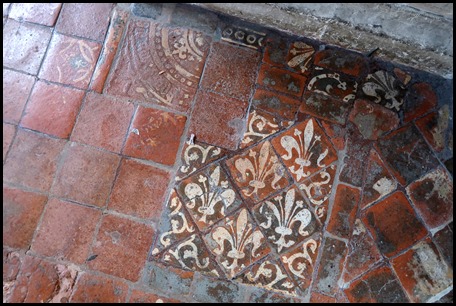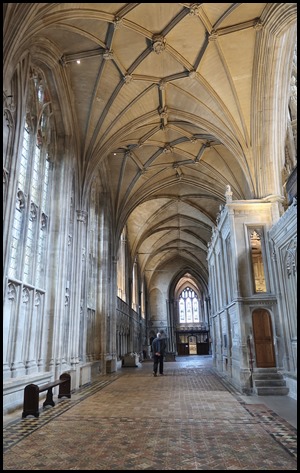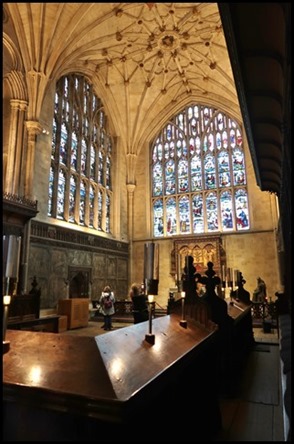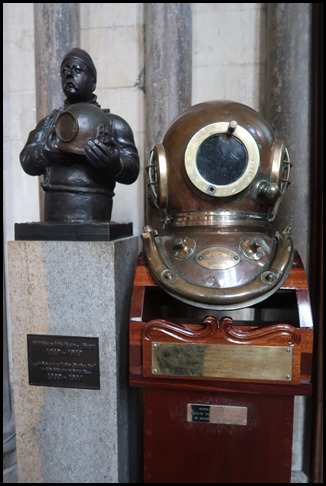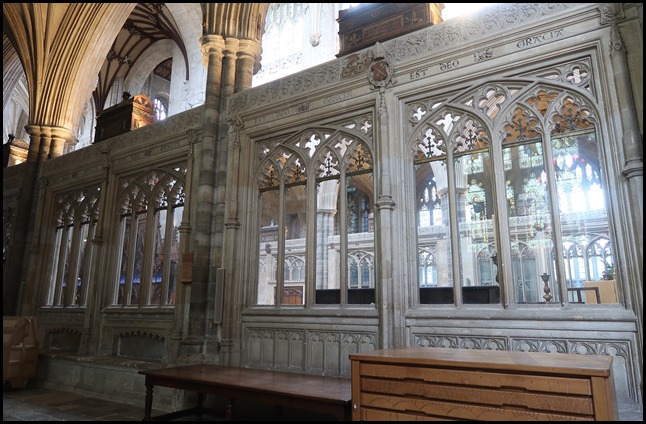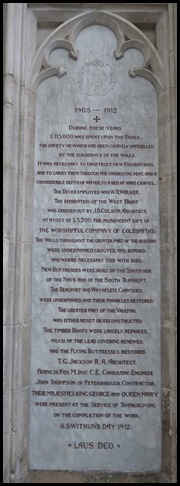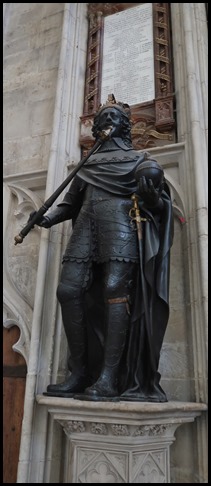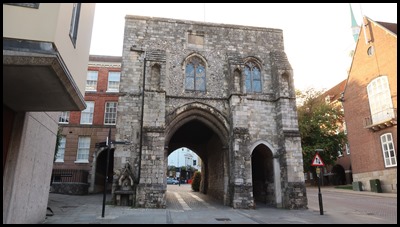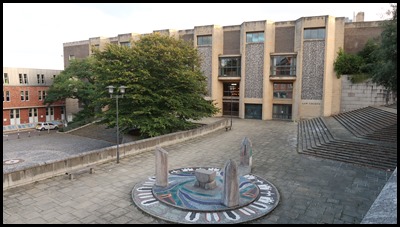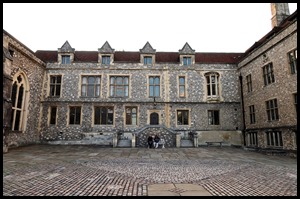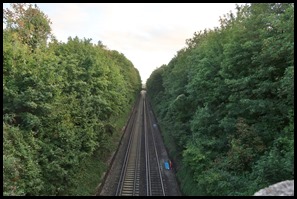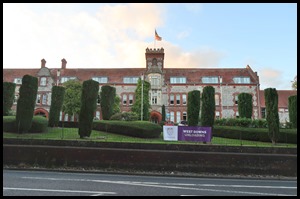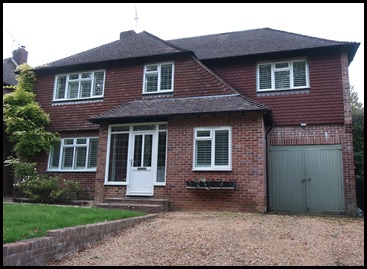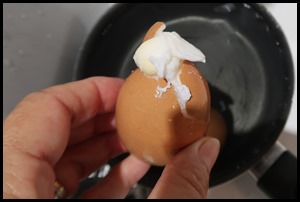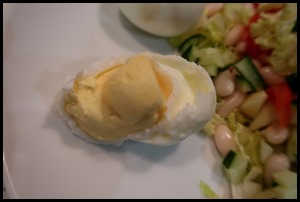Winchester Cath. Pt 2

|
Winchester Cathedral – Part
Two
I got left behind a bit because I was fascinated with the floor tiles, them I saw a wooden plaque that read: These mainly 13th century tiles are the largest and oldest area to survive in England. The tiles are very fragile and visitors are asked to walk on them with care. Quite incredible. Why oh why can I not go to a place, take a few pictures, add them to a blog with a few words and post it........ here I go with part two..........
Bear bimbles on, the Guardians Chapel beyond him at the far end. Next came the Lady Chapel. This chapel retains its early 16th century stalls and wall paintings depicting the legends of Our Lady. The reredos is a memorial to the novelist Charlotte Yonge, 1823-1901. The Pieta was created by Peter Eugene Ball (distant relative ???) with help from the Roman Catholic community of Winchester. Then a memorial to a diver called William Walker – who saved Winchester Cathedral. We would find out about him soon.
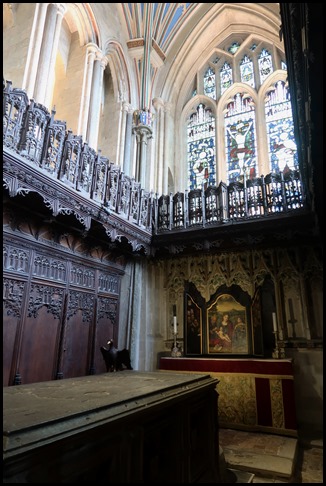 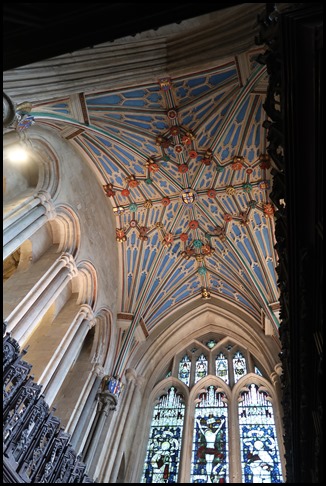
In the far back right corner was Bishop Langton’s Chapel again a lovely ceiling. Thomas Langton was Bishop of Winchester 1493-1501, Chaplain to Kings Edward IV and Richard III and Ambassador to France and Rome. During his episcopate the Channel Islands became part of this Diocese. He was elected Archbishop of Canterbury shortly before his sudden death.
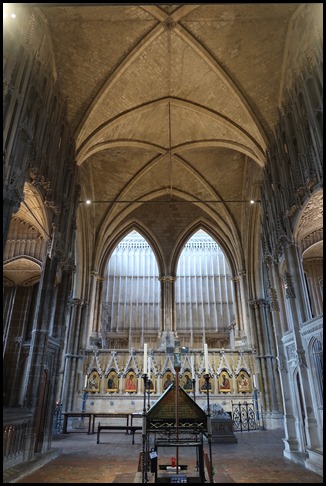 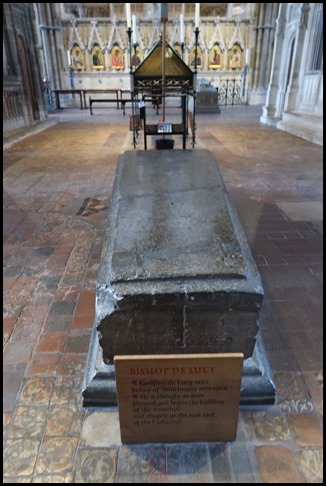
We turned to look at the Retrochoir. Bishop de Lucy was Bishop of Winchester 1189-1204. He is thought to have planned and begun the building of the retrochoir and chapels at the east end of the Cathedral.
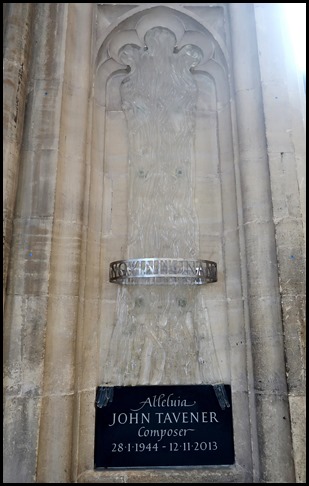 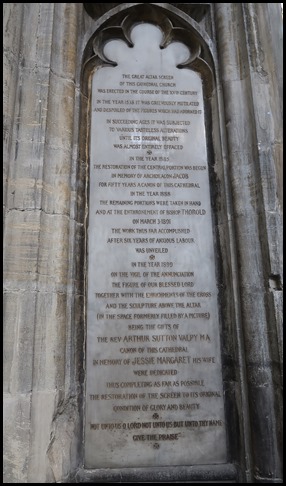 We carried on along the right aisle to find a lovely cascade of water as a memorial to John Tavener. The Guardian piece at the time read: John Tavener who has died peacefully at 69 at his home, was the single most popular British classical composer of the late 20th and 21st centuries. His music has become part of public consciousness, making him a unique cultural figure. When Tavener's Song for Athene was sung at Diana, Princess of Wales's funeral in 1997, the music's haunting austerity was a lightning conductor for the grief of the watching millions, its deceptive simplicity somehow expressing and comforting those teeming collective emotions. When his cello concerto, The Protecting Veil, was premiered at the Proms in 1989, the effect was similarly rapturous, as Steve Isserlis's playing transported the audience into a realm of mystical contemplation. The Lamb, a choral setting of William Blake from 1982, is another of Tavener's most celebrated works, music that's once heard, never forgotten, its delicate radiance realising a rapt timelessness. But Tavener was already famous before the 1980s. He was signed to the Beatles’ Apple label in the late 60s ("I was less surprised at John Lennon's enthusiasm, but I was surprised at Ringo's," he later said), and he was the only classical composer of his generation to approach pop-star fame............... Nearby a memorial which caught Bear’s eye and he enjoyed reading – very harsh indeed:- The Great Altar Screen of this Cathedral Church was erected in the course of the XVth century in the year 1538 it was grievously mutilated and despoiled of the figures which had adorned it. In succeeding ages it was subjected to various tasteless alterations until its original beauty was almost entirely effaced. In the year 1885 the restoration of the central portion was begun in memory of Archdeacon Jacob for fifty years a Canon of this Cathedral. In the year 1888 the remaining portions were taken in hand and at the enthronement of Bishop Thorold on March 3 1891 the work thus far accomplished after six years of anxious labour was unveiled. In the year 1899 on the vigil of the annunciation the figure of our Blessed Lord together with the enrichments of the Cross and the sculpture above the Altar (in the space formerly filled with a picture) being the gifts of the Rev Arthur Sutton Valpy MA Canon of this Cathedral in memory of his wife Jessie Margaret were dedicated. Thus completing as far as possible the restoration of the screen to its original condition of glory and beauty. “Not unto us O Lord not unto us but unto thy name give the praise”.
I needed a sit down after reading that. We bimbled under the Mortuary Chests once more taking in the Choir Screen en route to having another look at the altar screen.
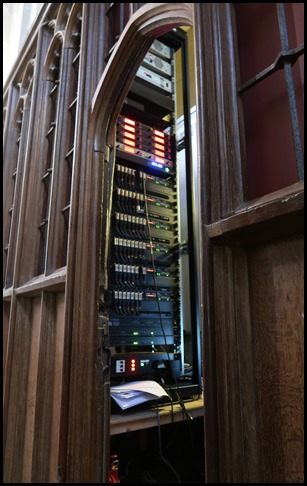 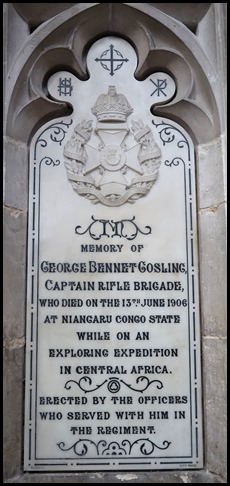
Even a Cathedral has busy electrickery........ A brave chap exploring Africa.
This is the very last one I’m going to type: 1905-1912. During these years £113,000 was spent upon the fabric, the safety of which had been gravely imperilled by the subsidence of the walls. It was necessary to construct new foundations and to carry them through the underlying peat, and a considerable depth of water, to a bed of hard gravel. The diver employed was W. R. Walker (our diver from the far end of the Cathedral) The reparation of the West Front was carried out by J.B. Colson, Architect at a cost of £5,500, the munificent gift of The Worshipful Company of Goldsmiths. The walls throughout the greater part of the building were underpinned, grouted, and bonded; and where necessary tied with rods. New buttresses were built on the South side of the Nave and of the South Transept. The Beaufort and Waynflete Chantries were underpinned and their pinnacles restored. The greater part of the vaulting was either reset or reconstructed. The timber roofs were largely repaired, much of the lead covering renewed, and the flying buttresses restored. T.G. Jackson R.A. Architect. Francis Fox M.Inst. C.E. Consulting Engineer. John Thompson of Peterborough. Contractor. Their Majesties King George and Queen Mary were present at the Service of Thanksgiving on the completion of the work. S.Swithin’s Day 1912. Laus Deo. Sounds like things were restored and repaired in the nick of time or this colossal building would have fallen.
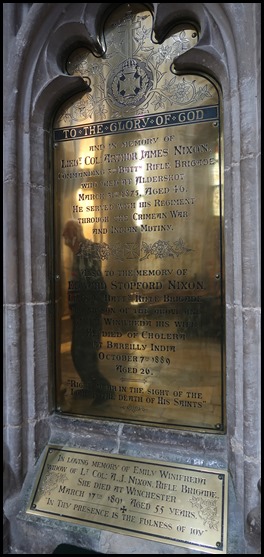 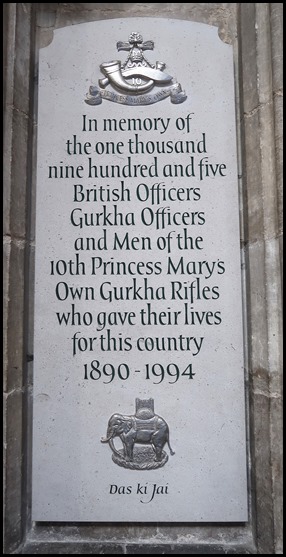 There is always one family that stands out, for me it was the Nixon Family. The brass memorial reads: To the Glory of God and in memory of Lieut. Col Arthur James Nixon, Commanding 3rd Battn. Rifle Brigade who died at Aldershot March 31st 1875. Aged 46. He served with his Regiment through the Crimean War and Indian Mutiny....... Also to the Memory of Edward Stopford Nixon. Lieut. 1st Battn. Rifle Brigade second son of the above and Emily Winifreda his wife. He died of cholera at Bareilly, India October 7th 1889. Aged 20........ Right dear in the sight of the Lord is the Death of His Saints....... The plaque below is: In loving memory of Emily Winefreda widow of Lt Col: A.J. Nixon, Rifle Brigade. She died at Winchester March 17th 1891 Aged 55 years..... “In thy Presence is the Fulness of Joy”. Our very last memorial fittingly, is to our favourites – The Gurkha Regiment.
We left the cathedral and walked toward Westgate, turned left to follow the sign to the round table. To our left the Law Courts.
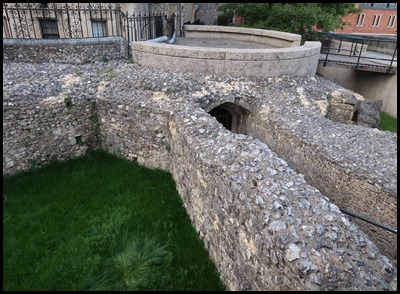 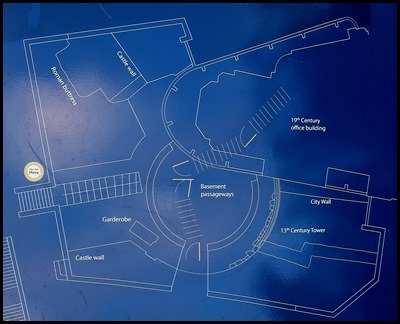 To our right: When Winchester was the capital of England,
a great castle stood on this spot and from here the King of England ruled
supreme across the dominion. Now, some 800 years later, all that remains is the
Great Hall and these ruins of a tower from the castle walls. These restored passageways in the basement of this tower, that
led out to the great dry moat surrounding the castle, offer a glimpse of a world
we can now only imagine, with a castle plan to
guide us.
Next to the ruins is the Great Hall of Winchester Castle hanging on the wall is the Round Table. Constructed from English oak it dates back to the later years of the 13th century, built under Henry III. Considered one of the finest surviving aisled halls of the 13th century, the Great Hall is all that remains of the medieval castle originally constructed for William the Conqueror in 1067. The round table is believed to have been made in about 1290, for a “Round Table” tournament (festival) near Winchester held to celebrate the betrothal of one of Edward I’s daughters. Sadly, the Hall was closed and we failed to charm our way in for a quick look. We bimbled toward our digs going over the railway line and passing quite an attractive university building.
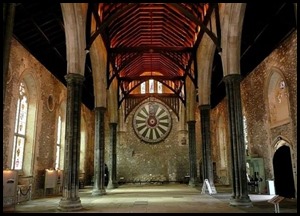 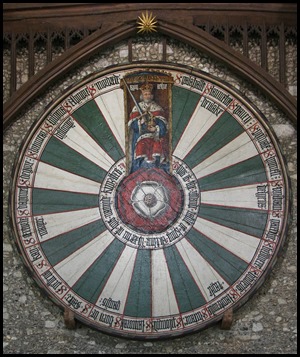 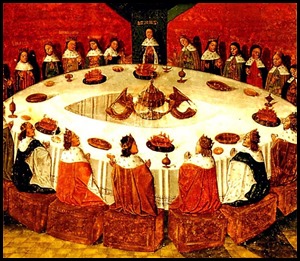
Later on I found these pictures (in the public domain). The Great Hall, the table and Evrard d’Espinques depiction of the knights sitting at the Round Table.
The tabletop measures 5.5 meters in diameter and weighs 1,200 kg. Though originally a table standing on legs, it has been displayed hanging on the west wall since 1873, when it was moved from the east wall where it had hung prior to that time (since at least 1540, and possibly since 1348). The artwork on the table today dates to the reign of Henry VIII who had the table painted with the Tudor Rose at its centre. The outer design is thought to portray Henry as King Arthur on his throne, surrounded by 24 places, each bearing the name of one of the legendary Knights of the Round Table.
Bimbling along our road back to our digs, we pass this handsome house up for rent. Just shy of three thousand pounds a month plus bills. Bear going in to our nest.
An egg event to make a colourful addition to my salad supper. Yay.
ALL IN ALL A VERY ENJOYABLE DAY AN IMPRESSIVE CATHEDRAL |
